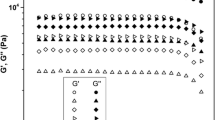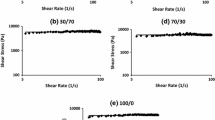Abstract
The viscoelastic characteristics of the blends of poly(methyl methacrylate)/poly(styrene-co-acrylonitrile) (PMMA/SAN) were investigated at various temperatures below, near, and above the phase separation temperature. The investigated polymer system is characterized by a lower critical solution temperature. Rheological behavior of the blends in the region of a phase separation was compared with change of the light scattering intensity. The presence of nanofillers in the blend results in that the phase separation occurs at a higher temperature. At the isothermal conditions, the phase separation begins earlier and proceeds with a higher rate as compared with the same blend without filler. The results of the study show the considerable change of the viscoelastic characteristics of PMMA/SAN when the polymer system passes from the homogeneous state to the heterogeneous one. Such characteristics as the dependence of the storage modulus (G ′) on the loss modulus (G ″), the dependence of the loss viscosity (η ″) on the dynamic viscosity (η ′), the dependences of the complex viscosity (η*), and the free volume fraction (f) on the blend composition are the most sensitive to the phase separation. The phase separation affects the characteristics G ′(ω), where ω is the frequency only in a low-frequency range. Temperatures of phase separation were estimated using dependence G ′(T) at ω, which is the constant in the range of low frequencies.











Similar content being viewed by others
References
Ajji A, Choplin L, Prud’homme RE (1988) Rheology and phase separation in polystyrene/poly(vinyl methyl ether) blends. J Polym Sci Polym Phys Ed 26:2279–2289
Araujo MA, Stadler R (1988) Viscoelastic properties of mixtures of polystyrene with low-molecular weight poly[oxy(2,6-dimethyl-1,4-phenylene)]. Makromol Chem 189:2169–2186
Bates FS (1984) Block copolymers near the microphase separation transition. 2. Linear dynamic mechanical properties. Macromolecules 17:2607–2613
Brekner MJ, Cantow HJ, Schneider HA (1985) Interactions in compatible polymer systems. 1. Viscoelasticity and glass transition of polystyrene/poly(vinyl methyl ether) blends. Polym Bull 14:17–24
Cahn JW (1965) Phase separation by spinodal decomposition in isotropic system. J Chem Phys 42:93–99
Elias L, Fenouillot F, Majeste JC, Cassagnau Ph (2007) Morphology and rheology of immiscible polymer blend with silica nanoparticles. Polymer 48:6029–6040
Katsaros JD, Malone MF, Winter HH (1989) The effects of flow on miscibility in a blend of polystyrene and poly(vinyl methyl ether). Polym Eng Sci 29:1434–1445
Kozlov GV, Lipatov YS (2002) Fractal and structural aspects of adhesion in particulate-filled polymer composites. J Compos Interfaces 9:509–527
Krause S (1978) Miscibility in the polymer–polymer systems. In: Paul DR, Newman S (eds) Polymer blends, vol 1. Academic Press, New York, pp 26–144
Kyu T, Saldanha JM (1988) Miscible blends of polycarbonate and poly(methyl methacrylate). J Polym Sci Polym Lett Ed 26:33–40
Lipatov YS, Nesterov AE (1992) Effect of filler concentration on the phase separation in poly(vinyl acetate)/poly(methyl methacrylate) mixtures. Polym Eng Sci 17:1261–1263
Lipatov YS, Nesterov AE, Ignatova TD, Nesterov DA (2002) Effect of polymer-filler surface interactions on the phase separation in polymer blends. Polymer 43:875–880
Malkin AY, Kulichikhin SG (1996) Stress-induced phase transitions in polymer systems. Vysokomol Soedin B38:362–374
Mani S, Malone MF, Winter HH et al (1991) Effects of shear on miscible polymer blends: in situ fluorescence studies. Macromolecules 24:5451–5458
Mani S, Malone MF, Winter HH (1992) Influence of phase separation on the linear viscoelastic behavior of a miscible polymer blend. J Rheol 36:1625–1649
Mazich KA, Carr SH (1983) The effect of flow on the miscibility of a polymer blend. J Appl Phys 54:5511–5514
Nesterov AE, Lipatov YS, Ignatova TD (2001) Effect of an interface with solid on the component distribution in separated phases of binary polymer mixtures. Eur Polym J 37:281–285
Palierne JF (1990) Linear rheology of viscoelastic emulsions with interfacial-tension. Rheol Acta 29:204–214
Prest WM, Porter RS (1972) Rheological properties of poly(2,6-dimethylphenylene oxide)–polystyrene blends. J Polym Sci A-2 10:1639–1655
Reich S, Cohen Y (1981) Phase separation of polymer blends in thin films. J Polym Sci Polym Phys Ed 19:1255–1267
Shumsky VF, Getmanchuk IP, Davydenko VV et al (2003) Viscoelastic behavior of chlorinated polyethylene/poly(ethylene-co-vinyl acetate) blends in the melt state. J Appl Polym Sci 88:1911–1918
Snyder HL, Meakin P, Reich S (1983) Dynamical aspects of phase separation in polymer blends. Macromolecules 16:757–762
Stadler R, Freitas LL, Krieger V, Klotz S (1988) Influence of the phase separation on the linear viscoelastic properties of a polystyrene-poly(vinyl methyl ether) blend. Polymer 29:1643–1647
Vernay V, Michel A (1985) Influence de la polydispersité sur le comportement rhéologique à l’état fondu du polypropylène. Rheol Acta 24:627–631
Vinogradov GV, Malkin AY (1980) Rheology of polymers. Khimia, Moscow
Voigt-Martin IG, Leister KH, Roseau R, Koningsveld R (1986) Kinetics of phase separation in polymer blends for deep quenches. J Polym Sci Polym Phys Ed 24:723–751
Wisniewski C, Marin G, Monge P (1985) Viscoelastic behavior of non-compatible polymer blends: polystyrene–polycarbonate. Eur Polym J 21:479–484
Zheng Q, Du M, Yang B (2002) Relationship between dynamic rheological behavior and phase separation of poly(methyl methacrylate)/poly(styrene-co-acrylonitrile) blends. Polymer 42:5743–5747
Author information
Authors and Affiliations
Corresponding author
Additional information
Contract grant sponsor: NATO, 2004.
Rights and permissions
About this article
Cite this article
Shumsky, V.F., Getmanchuk, I., Ignatova, T. et al. Effect of nanofillers on the phase separation and rheological properties of poly(methyl methacrylate)/poly(styrene-co-acrylonitrile) blends. Rheol Acta 49, 827–836 (2010). https://doi.org/10.1007/s00397-010-0447-8
Received:
Revised:
Accepted:
Published:
Issue Date:
DOI: https://doi.org/10.1007/s00397-010-0447-8




